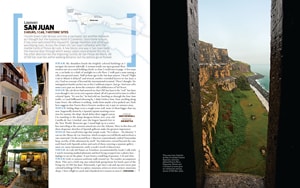Puerto Rico: Best Layover Trip
_
_
I hustle down Calle Monjas and into a courtyard, not another museum as I thought but the luxurious Hotel El Convento. Once home to nuns, it has since welcomed Rita Hayworth, George Hamilton and other sun-worshiping stars. Across the street sits San Juan Cathedral with the marble tomb of Ponce de León. A few blocks one way is San Juan Gate, the massive door through which weary sailors once entered the city. In the other direction lies the imposing Castillo de San Felipe del Morro. All of Old San Juan lies within walking distance, but my options go on forever.
9:35 a.m. My shoulders brush the brightly colored buildings as I navigate the narrow sidewalk. A woman inside one open ground-floor window sits on a couch holding a book, so close I could turn its page. A few steps on, a cat basks in a shaft of sunlight on a tile floor. I walk past a man tuning a cello, unexpected music. Half an hour ago in the San Juan airport, I heard "Flight 1736 to Miami is delayed" and winced, another extended layover in San Juan, a city I had no concept of beyond the international terminal. Then I thought: No immigration hassles anchor me at this Caribbean airport. Just go. And now cello notes carry past me down the centuries-old cobblestones of Sol Street.
9:40 a.m. My cab driver had assured me that Old San Juan is the "real" San Juan, even though it sits on its own separate island, all of it preserved in time to reflect colonial Spain. "It's not far," he had told me, hurtling us through the four-lane traffic, a Coach billboard whizzing by. I didn't believe him. Now, strolling along Luna Street, the stillness is striking. Aside from maybe a few parked cars, little here suggests that Puerto Rico's frenetic modern city is just 20 minutes away.
10:00 a.m. Sailing ships cover a rough stone wall, none of them bigger than my arm. Supposedly drawn by a Spanish captain awaiting execution for mutiny, the ships' detail defies their ragged canvas. I'm standing in the damp dungeon below 500-year-old Castillo de San Cristóbal, once the largest Spanish fort in the New World. Moments ago, I stood high up in a sentry box marveling at the cannons aimed out over the Atlantic. Here in this dim cell, these desperate sketches of Spanish galleons make the greatest impression.
10:20 a.m. Past a small white sign that simply reads, "No Culture = No Identity," I can see the Museo de Las Américas, which occupies several blocks and encloses a vast courtyard. On the second floor, I discover a meticulously crafted Venezuelan harp, worthy of the admission by itself. Two balconies extend beyond the case, each lined with Spanish arches and each of those entering a separate gallery — more art, more instruments, easily a week's worth of discoveries.
11:00 a.m. At Cafe del Punto on Forteleza, recommended by locals I talk with, I watch steaming mashed plantains and beef being scooped into a plastic box — mofongo to eat on the plane. It sure beats a small bag of peanuts. I sit and relax.
11:30 a.m. Girls in maroon uniforms walk toward me. No teacher accompanies them. This isn't a field trip, just school kids going home for lunch, part of the living city of Old San Juan. Reluctantly, I get into a cab and zip once more past colonial buildings I'd like to explore, museums, artists on street corners, musicians, shops. I have a flight to catch and a hundred new reasons to miss it.
